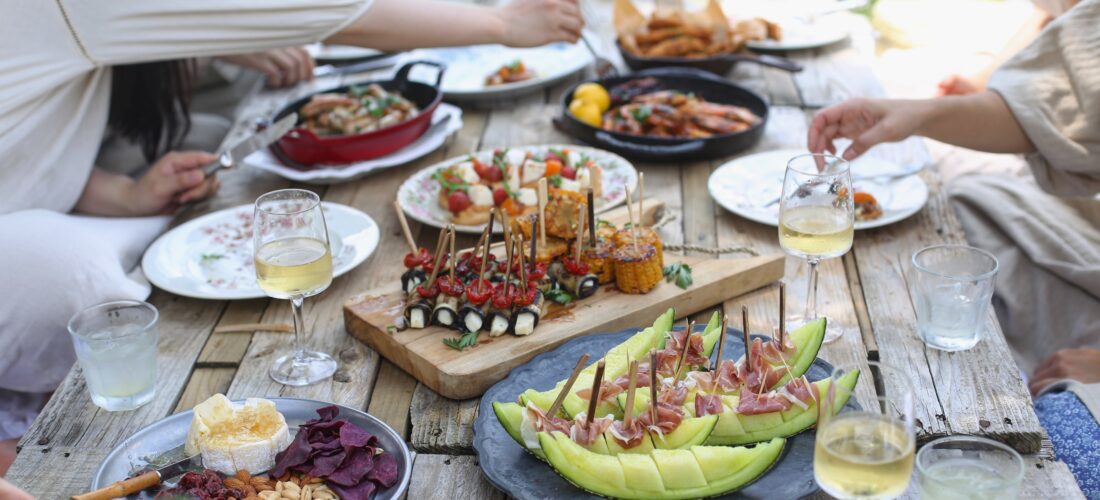Have you ever held a dinner party where everyone brings a different component to the dinner? A bit like a bring and share type of event but one which is a bit more structured and planned? Aren’t they just the best kind of dinner party? Here’s ten benefits I think this kind of dinner party has going for it:
- One person hosts/coordinates but does not have to take on the entire workload of providing everything.
- All attendees to the party get to contribute something.
- People can make things they are good at making or even bring pre-made things that fit well into the menu.
- The process of planning and bring together the menu helps everyone to see what the overall meal plan is.
- The variety of dishes means that everyone will have something they can eat, perhaps something new they can try and things they can choose not to eat.
- The conversations around the table are enriched by discussions about the food people have brought with them.
- With coordinated planning there will be a balance of starters, mains, desserts etc so that the balance of the meal feel right.
- People’s dietary requirements can be easily taken into account.
- The accompanying drinks and refreshments can also be a shared activity and linked to the foods being eaten.
- There’s a good excuse for people to go back to the hosts house at a later date to collect their cleaned dishes and have a catch-up.
I’m hoping by now that some of you have started to see some potential links here with the dinner party and curriculum design – if you haven’t then don’t worry as I’m going to set out the analogy for you below.
A key component of both the dinner party and curriculum design is that there is a person(s) who take on the responsibility of leading/co-ordinating the activity. In the case of the dinner party this will almost certainly be the host, in a curriculum sense this will be the course leader / programme director. The important consideration is that this person is the glue who sticks it all together and makes sure that the experience is coherent. After all, who wants to turn up to a dinner party where there is poppadoms and pickles for a starter and then wild mushroom risotto for the main?
Whilst the host may coordinate the event, it is the shared process of each bringing a dish to the table that enhances the experience, the same is true in course design. Each person can bring something to the table, whether that be a module they have designed, a pedagogic approach they know will work, or an understanding of the way in which different modes of learning influences the ways in which we teach, it is the collective endeavours of each person that will make the course experience the best it can be. Therefore it’s important that the right people have a seat at the table. The SPaM framework can help you identify who needs to be invited and who will be bringing which ingredients/dishes to the party. Below I have started to map some examples of the types of roles who it might be useful to bring to your curriculum design table.
| Subject | Pedagogy | Modality |
|---|---|---|
| Academic Staff (subject expert) Employer(s) Subject Librarian External Examiner Student | Academic Staff (learning & teaching) Educational Developer (pedagogy) Instructional Designer Student Academic Developer | Learning Technologist Educational Developer (digital) Instructional Designer Content Developer |
Clearly, this list isn’t exhaustive and the roles are fluid across domains and your specific context will influence the roles you have available to include in the process, but the point here is that for hybrid education it is vital to ensure that you have the right expertise and perspectives at the table and that we make the most of individuals’ specialisms. The SPaM framework can help you consider who brings what to the discussion and whilst there may be some individuals who can bring all three to the table, having a mix of voices will help ensure that a single insular view is not the one to dominate the design and in most cases these individuals will have a specialism weighted in one area more than the other.
What is critical in both the curriculum design and the dinner party is that each component will influence and inform the other. Making changes to the modality (dessert) may impact on the experience of the pedagogy (main) and the subject (starter) and so the programme director (host) must maintain oversight of the curriculum design process.
So, if we revisit our list of ten dinner party benefits they also align quite well in a curriculum design sense:
- One person hosts/coordinates but does not have to take on the entire workload of providing everything.
- All attendees to the
partycurriculum design process get to contribute something. - People can
make things they are good at makingmake use of their expertise and even bringpre-madepre-tested things that fit well into themenucourse/programme. - The process of planning and bring together the
menucourse/programme helps everyone to see what the overallmeal plancourse structure will be. - The variety of
dishesvoices means that everyone will have something they caneatcontribute, perhaps something new they can try and things theycan choose not to eatcan agree might not work. - The conversations around the table are enriched by discussions about the
foodmodules/assessments/modality/experiences people have brought with them. - With coordinated planning there will be a balance of
starters, mains, dessertsapproaches and activities etc so that the balance of themeallearning feels right. - People’s
dietaryteaching requirements can beeasilyholistically taken into account. - The accompanying
drinks and refreshmentsdiscussions on teaching activities and assessments can also be a shared activity and linked tothe foods being eatena more holistic approach to teaching. - There’s a good excuse for people to go back to the
hosts housecourse director at a later date tocollect their cleaned dishes andhave follow-up discussions and a catch-up.
Now, admittedly some of these are more tenuous than others, but you get the idea. The SPaM framework doesn’t seek to define the dishes or the ingredients, but acts as a framework to structure the menu and to make sure all the dishes offer a coherent and high quality experience.
Now, the ultimate approach would be to have the curriculum design workshop run as a dinner party – anyone up for that?

